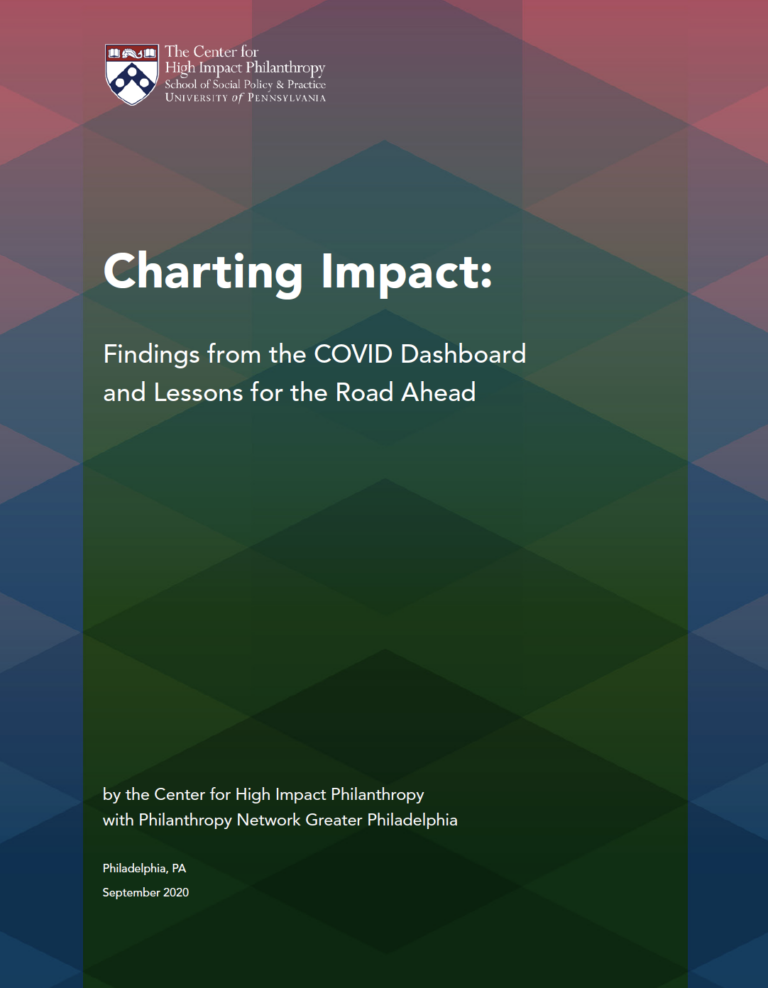Developed by the Center for High Impact Philanthropy (CHIP) at the University of Pennsylvania and Philanthropy Network Greater Philadelphia, with support from William Penn and Lenfest Foundations, the dashboard is one of the first efforts to collect grants data from numerous pooled giving funds and share it publicly, mapped against demographic and economic data. By visualizing funding to date and where need remains high, this dashboard serves as a community asset to help all funders plan beyond the initial COVID-19 relief efforts.
Data provided by 13 COVID-19 philanthropic response funds in Southeastern Pennsylvania and Southern New Jersey revealed 4,892 grants totaling more than $40 million made across 10 counties in the region between March 18 and June 29, 2020. These funds represent the majority of the collective funding launched to provide relief from the initial effects caused by COVID-19.
The project was developed by CHIP at the School of Social Policy & Practice at the University of Pennsylvania, with additional collaboration from Penn's Actionable Intelligence for Social Policy and Urban Spatial.
► VIEW A RECORDING OF THE WEBINAR: REGIONAL COVID-19 RESPONSE DASHBOARD - FINDINGS & LESSON LEARNED
REPORT: Charting Impact: Findings from the COVID Dashboard and Lessons for the Road Ahead
 A companion report to the dashboard summarizes key take-aways from the data, lessons learned in the development of the dashboard and implications for continued COVID response, crisis grantmaking and philanthropy overall.
A companion report to the dashboard summarizes key take-aways from the data, lessons learned in the development of the dashboard and implications for continued COVID response, crisis grantmaking and philanthropy overall.
Key Findings
- Grant Size: Ninety-five percent of grantees received grants of $50,000 or less, with the majority under $10,000. The average grant size was $8,211.
- Community Needs: Grants were intended to address community needs that emerged during the pandemic. The top six needs that participating shared funds addressed were: Economic Activity ($13,247,754), Education ($11,890,452), Health ($11,364,296, including $5,120,265 for food, agriculture, and nutrition aid), Human Services ($7,884,128), Arts and Culture ($4,069,949), and Housing ($2,355,587).
- Funding in Philadelphia: Most grant funds (57%, $21,786,047) went to nonprofits based in Philadelphia. That level of response seemed well aligned for two reasons: (1) Philadelphia is a county with high need. Of the 10 counties tracked, Philadelphia has the highest average Social Vulnerability Index and the fourth highest COVID-19 death rate; and (2) many nonprofits with Philadelphia-based addresses serve individuals and families across the region.
- Funding in Suburban Counties: Giving in other counties was mostly commensurate with need and population, with a few notable exceptions. Bucks and Chester counties had relatively high per capita grant awards ($8.04, third highest, and $6.20, fourth highest, respectively), but low Social Vulnerability (9th and 10th ranked) and COVID-19 rates (7th and 10th ranked). In contrast, rural Cumberland County in New Jersey had the 2nd highest Social Vulnerability, just behind Philadelphia, but the lowest granting, at just $0.62 per capita.
Among the potential opportunities to strengthen the preparedness of funders across the region for the next crisis:
- Developing a common crisis grantmaking application, ready in advance to be adapted to disasters or crises and used by all shared funds to improve coordination and targeting of what will always be limited philanthropic funds;
- Develop an automated tool for importing applicant data real time into the dashboard visualizations and maps so that participating funds and follow-on users have the benefit of current information for planning;
- Develop a minimum data standard to be used regionally in crises and regular, non-crisis reporting and grantmaking. Asking for a minimum, standardized set of data will facilitate reporting for nonprofits and allow for better collaboration and sharing among funders.
►DOWNLOAD the full report. Questions regarding the dashboard can be emailed to impact@sp2.upenn.edu.
Media Coverage
- You asked ‘How can I help?’ and CHIP found answers By Lynette Hazelton for Generocity (05.19.21)
- As of October, this is what we know about philanthropic COVID relief in the Philadelphia region - by Lynette Hazelton for Generocity (10.09.20)
- A dashboard’s promise: A better funding approach to COVID-19 - by Lynette Hazelton for Generocity (07.24.20)

